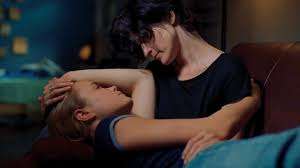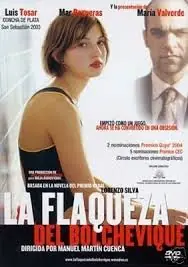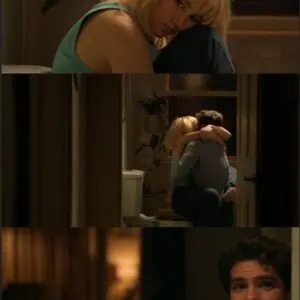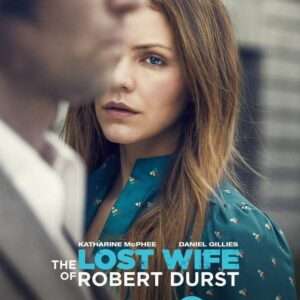Lisa Cholodenko’s High Art (1998) is a film of quiet intensity, a slow-burning and deeply introspective drama that explores the blurred boundaries between art and life, ambition and integrity, desire and destruction. A landmark of 1990s queer cinema, High Art is at once a tender love story and a sharp commentary on the seductions and sacrifices of the creative world.
The story centers on Syd (Radha Mitchell), a 24-year-old assistant editor at Frame, a prominent photography magazine. Bright, ambitious, and naive, Syd is eager to prove herself in the competitive art world. A leak in her apartment ceiling leads her to meet her upstairs neighbor—Lucia (Ally Sheedy), a once-famous photographer who has since retreated into a shadowy, reclusive lifestyle. As the two women are drawn into each other’s orbits, Syd is seduced not only by the possibilities of artistic success but also by Lucia herself.
A Collision of Worlds
From the moment Syd enters Lucia’s apartment, the contrast between their worlds is stark. Syd’s structured, upwardly-mobile life clashes with the messy, drug-hazed, bohemian chaos of Lucia’s. Lucia lives with her girlfriend Greta (Patricia Clarkson), a former German actress who is now a heroin addict. Their apartment, dark and cluttered with relics of the past, acts as both a physical and symbolic space where time seems suspended. It is within this space that Syd begins to unravel emotionally and creatively.

The film presents a layered exploration of how these two women transform each other. Syd sees in Lucia a portal to artistic authenticity and sexual liberation. Lucia, in turn, finds in Syd a muse who rekindles her creative spark and offers her a chance at redemption. Their relationship develops gradually, shaded by ambiguity, longing, and an undeniable erotic tension. Their eventual love affair is treated with emotional honesty, avoiding cliché or sensationalism. Cholodenko’s treatment of queer romance is notable for its realism and restraint, a rarity in cinema at the time.
Photography as a Metaphor
Photography in High Art is more than a narrative device—it is a metaphor for seeing and being seen. The medium becomes a lens through which power, intimacy, and identity are mediated. Lucia’s old photographs, revered in the art world, capture the raw truth of marginalized lives. Yet, she has become disillusioned with the commodification of her work and the superficiality of the gallery scene.
When Syd offers Lucia a chance to be featured in Frame, it marks a reentry into the world Lucia had abandoned. The professional collaboration between the two blurs into personal territory, and the creative process becomes a form of seduction. Cholodenko deftly explores how art can both reveal and exploit, how the camera can be a tool of connection or domination. As Lucia rediscovers her creative purpose, she simultaneously risks losing herself again to the very forces she once escaped.
Performance and Presence

Ally Sheedy delivers a career-defining performance as Lucia. Known primarily for her roles in 1980s films like The Breakfast Club, Sheedy brings a raw vulnerability and world-weariness to the role that is both haunting and magnetic. She inhabits the character with a lived-in authenticity, making Lucia enigmatic yet heartbreakingly human.
Radha Mitchell, in her breakout role, captures the delicate transformation of Syd with nuance and restraint. Syd begins as a somewhat passive observer, but over the course of the film, she asserts herself emotionally and professionally. Mitchell allows us to see Syd’s internal struggle without ever resorting to melodrama. The chemistry between the two leads is electric, rooted in a slow-build intimacy that feels organic.
Patricia Clarkson also deserves mention for her devastating portrayal of Greta, a woman unraveling from addiction and abandonment. Clarkson’s performance is both chilling and pitiable, adding a layer of danger and pathos to the already volatile dynamic in Lucia’s home.
A Feminist and Queer Lens
Cholodenko’s script is deeply feminist and unapologetically queer. The narrative is driven by female perspectives, female desire, and female creativity—rare elements in late-1990s cinema. The film doesn’t frame queerness as a dramatic twist or a plot device but rather as a natural part of the characters’ identities and relationships. Syd and Lucia’s attraction is presented without judgment or fanfare, making the story feel authentic rather than performative.
Moreover, the film critiques the gender dynamics in the art and publishing worlds. Syd’s navigation of a male-dominated magazine industry, and Lucia’s experience with fame and exploitation, highlight the systemic barriers women face in asserting artistic control and gaining recognition on their own terms.
Mood and Aesthetic

The cinematography by Tami Reiker is moody and intimate, favoring soft light and close, almost voyeuristic framing. The camera lingers on faces, gestures, and details—mirroring the visual language of photography and enhancing the emotional texture of the film. The pacing is deliberately slow, inviting the audience to inhabit the characters’ silences and uncertainties. The film’s aesthetic is subtle yet richly atmospheric, reinforcing the themes of artistic vision and emotional exposure.
The soundtrack, featuring music by Shudder to Think and others, complements the tone perfectly—dreamy, melancholic, and edgy. It feels like the aural equivalent of Lucia’s photographs: haunting snapshots of lives in limbo.
A Tragic Undercurrent
As the film progresses, it becomes clear that Lucia’s addiction and self-destructive tendencies are never far from the surface. While Syd offers hope and connection, the shadows of the past are too deep to ignore. The final act of the film is devastating in its quiet inevitability. Without giving too much away, High Art ends not with triumph but with the melancholy acknowledgment that love and art do not always conquer all. The sacrifices made in the name of passion—creative or romantic—can be irreversible.
Conclusion
High Art is a masterful debut by Lisa Cholodenko, a film that lingers long after the credits roll. It’s an intimate exploration of women’s lives and desires, a meditation on the costs of creation and the fragility of connection. More than two decades later, the film remains deeply resonant—not only as a piece of queer cinema history but also as a timeless portrait of the complexities of intimacy and ambition.
Cholodenko’s restrained direction, combined with powerful performances and a compelling visual style, makes High Art a quietly radical film. It challenges viewers to question what we value in art, who gets to define it, and what we are willing to lose in its pursuit. For anyone who has ever been drawn to someone who seemed to hold the key to a deeper truth, High Art is both a warning and a revelation.





